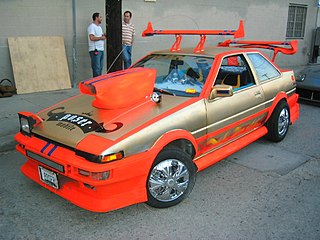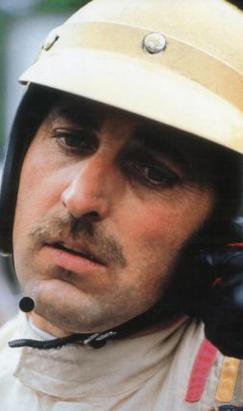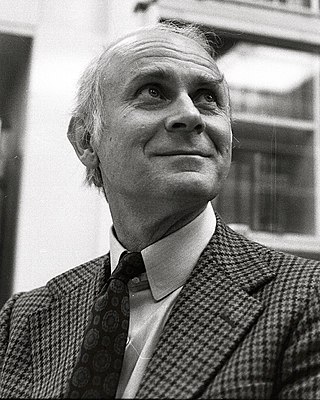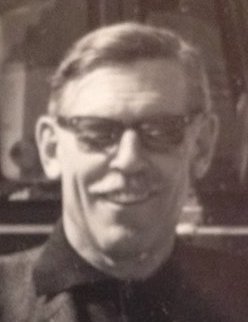Motor Racing Developments Ltd., commonly known as Brabham, was a British racing car manufacturer and Formula One racing team. Founded in 1960 by Australian driver Jack Brabham and British-Australian designer Ron Tauranac, the team won four Drivers' and two Constructors' World Championships in its 30-year Formula One history. Jack Brabham's 1966 FIA Drivers' Championship remains the only such achievement using a car bearing the driver's own name.

Drag racing is a type of motor racing in which automobiles or motorcycles compete, usually two at a time, to be first to cross a set finish line. The race follows a short, straight course from a standing start over a measured distance, most commonly 1⁄4 mi, with a shorter, 1,000 ft distance becoming increasingly popular, as it has become the standard for Top Fuel dragsters and Funny Cars, where some major bracket races and other sanctioning bodies have adopted it as the standard. The 1⁄8 mi is also popular in some circles. Electronic timing and speed sensing systems have been used to record race results since the 1960s.

Karl Jochen Rindt was a German-born racing driver who competed with an Austrian license during his career, despite having German and not Austrian citizenship. In 1970, he was killed during practice for the Italian Grand Prix and became the only driver to be posthumously awarded the Formula One World Drivers' Championship.

Ferdinand Porsche was an Austro-Bohemian automotive engineer and founder of the Porsche AG. He is best known for creating the first gasoline–electric hybrid vehicle (Lohner–Porsche), the Volkswagen Beetle, the Auto Union racing cars, the Mercedes-Benz SS/SSK, and several other important developments and Porsche automobiles.

Boy racer is a term given to a young person who drives in a fast and aggressive manner; it has become a broader term for participants in modern custom car culture who tune and modify cars with street racing-style aftermarket cosmetic and performance parts such as body kits, audio systems and exhausts. The culture encompasses a broad range of car types including sport compacts and economy cars typical of the import scene, this is in contrast with the hot rod culture of previous generations. Some car enthusiasts and modifiers feel the term labels them as deviant and anti-social and are keen to distance themselves from the term. Boy racer is a term mostly but not exclusively associated with the UK, in Australia and New Zealand hoon is sometimes preferred. In the US, "Rice boy" or "Ricer" is a derogatory term for the driver or builder of an imported hot rod, or someone who modifies their car in a cheap way to imitate the look of a higher performance vehicle.

Daniel Sexton Gurney was an American racing driver, race car constructor, and team owner who reached racing's highest levels starting in 1958. Gurney won races in the Formula One, Indy Car, NASCAR, Can-Am, and Trans-Am Series. Gurney is the first of three drivers to have won races in sports cars (1958), Formula One (1962), NASCAR (1963), and Indy cars (1967), the other two being Mario Andretti and Juan Pablo Montoya.

Mika Juhani Salo is a Finnish former professional racing driver. He competed in Formula One between 1994 and 2002. His best ranking was 10th in the world championship in 1999, when he stood in for the injured Michael Schumacher at Ferrari for six races, scoring two podiums and contributing to Ferrari's constructors' championship win. He also won the GT2 class in the 2008 and 2009 24 Hours of Le Mans.

Joseph Théodule Marie Schlesser was a French Formula One and sports car racing driver. He participated in three World Championship Grands Prix, including the 1968 French Grand Prix in which he was killed. He scored no championship points. He was the uncle of Jean-Louis Schlesser who himself became a Formula One driver in the 1980s.

Raymond Donald Evernham Jr. is an American consultant for Hendrick Companies, formerly an auto racing crew chief for Bill Davis Racing and Hendrick Motorsports, owner of his own team Evernham Motorsports from 2001 to 2010, and analyst for ESPN's NASCAR coverage. A three time Winston Cup Series Champion with driver Jeff Gordon, in 1999, Evernham won the NASCAR Winston Cup Illustrated "Person of the Year". Evernham was inducted to the NASCAR Hall of Fame, Class of 2018.

The 1988 24 Hours of Le Mans was the 56th Grand Prix of Endurance as well as the fifth round of the 1988 World Sports-Prototype Championship. It took place at the Circuit de la Sarthe, France, on the 11 and 12 June 1988. At their third attempt, Jaguar arrived with five cars to take on the strong Porsche works team of three cars, in their only race for the Championship season. The other potential rival was Sauber, now formally backed by Mercedes-Benz, but after a major high-speed tyre-blowout in practice, their two-car team was withdrawn.

The 1986 24 Hours of Le Mans was the 54th Grand Prix of Endurance as well as the third round of the 1986 World Sports-Prototype Championship. It took place at the Circuit de la Sarthe, France, on 31 May and 1 June 1986. This year saw the return of a full Jaguar works team, to take on the strong Porsche works and customer teams. However, with the fuel regulations relaxed, the turbo-charged cars would be able to use more of their potential power to outrun the normally-aspirated 6-litre Jaguars.

The 1985 24 Hours of Le Mans was the 53rd Grand Prix of Endurance, as well as the fourth round of the 1985 World Endurance Championship. It took place at the Circuit de la Sarthe, France, on 15 and 16 June 1985. The works Porsche team returned, with a Group C version of the 962. As favourites, they could expect from their customer teams and the works Lancias. In qualifying, Hans-Joachim Stuck set a new lap record in his works Porsche, with an average speed over 250 km/h for the first time. Mercedes returned for the first time in 30 years, as engine supplier to the Sauber team. The return was short-lived though, as the car got airborne in practice and crashed. With tighter fuel regulations this year from FISA, the teams would have to be more mindful of fuel economy and speed. However, from the start the Joest and Richard Lloyd Racing teams had the measure of the field. Working in tandem, Klaus Ludwig and Jonathon Palmer took turns leading and slipstreaming behind the other. Then at 9pm Jean-Claude Andruet had a major accident when his WM had a tyre blow out a high speed at the Mulsanne kink, sending him into the Armco barriers. Andruet was uninjured, but the race went behind the pace-cars for a half-hour as repairs were done. Just as the race resumed James Weaver pitted the RLR Porsche with an engine misfire. Traced to a faulty sensor, they returned to the race in 7th.

The 1984 24 Hours of Le Mans was the 52nd Grand Prix of Endurance, and took place on 16 – 17 June 1984. It was also the third round of the 1984 World Endurance Championship. There were two big stories going into the race weekend: the absence of the Porsche works team and their drivers, and the return of Jaguar. Bob Tullius had commissioned the new Jaguar XJR-5 to run in the IMSA series and entered two for Le Mans. Earlier in the year, FISA had announced abrupt changes to the fuel regulations to bring them more in line with IMSA. Porsche and Lancia objected strongly because of their strong investment in the existing rules. In the absence of dominant Porsche works team, the race was left wide open between Lancia and the number of strong Porsche customer teams.

The 1933 24 Hours of Le Mans was the 11th Grand Prix of Endurance. It took place at the Circuit de la Sarthe on 17 and 18 June 1933. Up against five strong privateer entries from Alfa Romeo, the opposition looked fairly weak, mostly being of 1920s vintage. There was a strong British contingent in the smaller classes. The big drawcard was the presence of top European drivers Louis Chiron and Tazio Nuvolari. The current European champion was paired with one of the previous year's winners, Raymond Sommer

German humour is the conventions of comedy and its cultural meaning within the country of Germany. German humour encompasses traditions such as Kabarett and other forms of satire as well as more recent trends such as TV shows and stand-up comedy.

Fritz Sittig Enno Werner von Hanstein nicknamed "Huschke von Hanstein", was a German racing driver who from the 1950s served both as Porsche's public relations manager and chief of their racing department.

The Auto Union Grand Prix racing cars types A to D were developed and built by a specialist racing department of Auto Union's Horch works in Zwickau, Germany, between 1933 and 1939, after the company bought a design by Dr. Ferdinand Porsche in 1933. The Auto Union type B streamlined body was designed by Paul Jaray.

Lucas Luhr is a German BMW factory racing driver, currently competing for BMW and Rahal Letterman Lanigan Racing in the GTLM category of the Tudor United SportsCar Championship.

Timo Bernhard is a former driver from Germany. He was a sports car driver from Porsche, but was seconded to Audi for selected events in 2009 and 2010. He is the ninth and most recent driver to complete the informal triple crown of endurance racing. On 29 June 2018, he became the first person in 35 years to break the all-time Nürburgring Nordschleife lap record, set by Stefan Bellof in 1983 with a Porsche 956, in a derestricted Porsche 919 Evo with a time of 5:19.546.

Manta, Manta is a 1991 German action comedy film directed by Wolfgang Büld. The film features Til Schweiger, Tina Ruland, Stefan Gebelhoff, Lena Sabine Berg and Michael Kessler in the lead roles. Singer/songwriter Sylkie Monoff makes a small appearance. It was released in Germany on 3 October 1991 and in Hungary on 17 April 1992. The English title of the film was Racin' in the Street. Four weeks before the film was released Manta – Der Film was shown in theaters, which also focused on Opel Manta in a comedic way, see "Manta jokes".



















